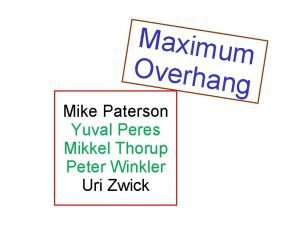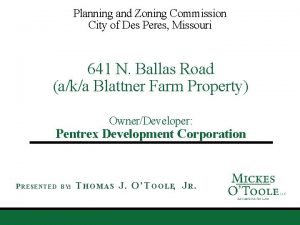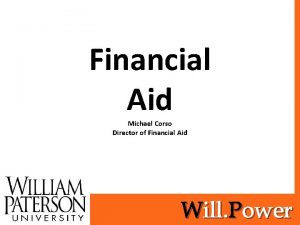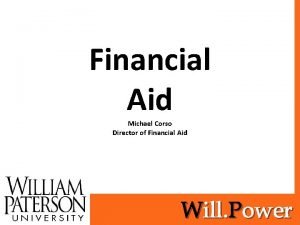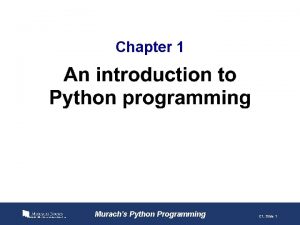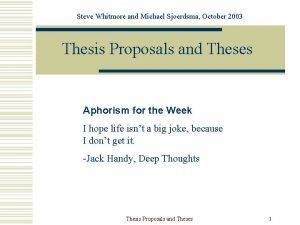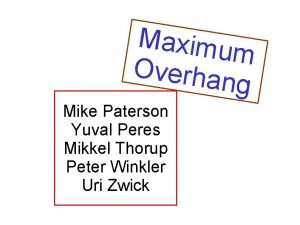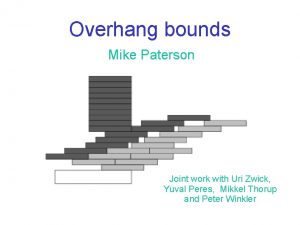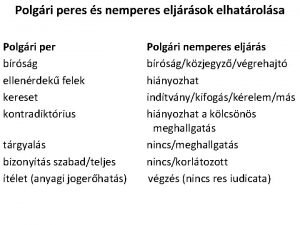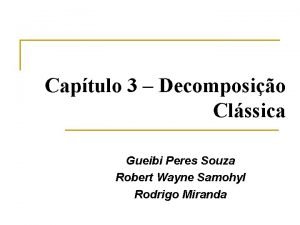Maximu m Overha ng Mike Paterson Yuval Peres

























































- Slides: 57

Maximu m Overha ng Mike Paterson Yuval Peres Mikkel Thorup Peter Winkler Uri Zwick

The overhang problem How far off the edge of the table can we reach by stacking n identical blocks of length 1? J. B. Phear – Elementary Mechanics (1850) J. G. Coffin – Problem 3009, American Mathematical Monthly (1923). No friction Length parallel to table “Real-life” 3 D version Idealized 2 D version

The classical solution Using n blocks we can get an overhang of Harmonic Stacks

Is the classical solution optimal? Obviously not!

Inverted triangles? Balanced?


Inverted triangles? Balanced?

Inverted triangles? Unbalanced!

Diamonds? The 4 -diamond is balanced

Diamonds? The 5 -diamond is …

Diamonds? The 5 -diamond is Unbalanced!

What really happens?

What really happens!

Why is this unbalanced?

… and this balanced?

Equilibrium F 1 F 2 F 4 F 3 F 1 + F 2 + F 3 = F 4 + F 5 x 1 F 1+ x 2 F 2+ x 3 F 3 = x 4 F 4+ x 5 F 5 Force equation Moment equation

Forces between blocks Assumption: No friction. All forces are vertical. Equivalent sets of forces

Balance Definition: A stack of blocks is balanced iff there is an admissible set of forces under which each block is in equilibrium. 1 1 3

Checking balance

Checking balance F 2 F 1 F 3 F 4 F 5 F 11 F 7 F 8 F 9 F 10 F 13 F 14 F 15 F 16 F 12 Equivalent to the feasibility of a set of linear inequalities: F 17 F 18 Static indeterminacy: balancing forces, if they exist, are usually not unique!

Balance, Stability and Collapse Most of the stacks considered are precariously balanced, i. e. , they are in an unstable equilibrium. In most cases the stacks can be made stable by small modifications. The way unbalanced stacks collapse can be determined in polynomial time

Small optimal stacks Blocks = 4 Overhang = 1. 16789 Blocks = 5 Overhang = 1. 30455 Blocks = 6 Overhang = 1. 4367 Blocks = 7 Overhang = 1. 53005

Small optimal stacks Blocks = 16 Overhang = 2. 14384 Blocks = 17 Overhang = 2. 1909 Blocks = 18 Overhang = 2. 23457 Blocks = 19 Overhang = 2. 27713

Support and balancing blocks Balancing set Principal block Support set

Support and balancing blocks Balancing set Principal block Support set

Loaded stacks Stacks with downward external forces acting on them Size = Principal block number of blocks + sum of external forces. Support set

Spinal stacks Stacks in which the support set contains only one block at each level Principal block Support set Assumed to be optimal in: J. F. Hall, Fun with stacking Blocks, American Journal of Physics 73(12), 1107 -1116, 2005.

Loaded vs. standard stacks Loaded stacks are slightly more powerful. Conjecture: The difference is bounded by a constant.

… Optimal spinal stacks Optimality condition:

Spinal overhang Let S (n) be the maximal overhang achievable using a spinal stack with n blocks. Let S*(n) be the maximal overhang achievable using a loaded spinal stack on total weight n. Theorem: Conjecture: A factor of 2 improvement over harmonic stacks!

Optimal 100 -block spinal stack Towers Shield Spine

Optimal weight 100 loaded spinal stack

Loaded spinal stack + shield

spinal stack + shield + towers

Are spinal stacks optimal? No! Support set is not spinal! Blocks = 20 Overhang = 2. 32014 Tiny gap

Optimal 30 -block stack Blocks = 30 Overhang = 2. 70909

Optimal (? ) weight 100 construction Weight = 100 Blocks = 49 Overhang = 4. 2390

Brick-wall constructions

Brick-wall constructions

“Parabolic” constructions 6 -stack Number of blocks: Balanced! Overhang:

Using n blocks we can get an overhang of (n 1/3) !!! An exponential improvement over the O(log n) overhang of spinal stacks !!!

“Parabolic” constructions 6 -slab 5 -slab 4 -slab

r-slab

r-slab within a (r+1)-slab


“Vases” Weight = 1151. 76 Blocks = 1043 Overhang = 10

“Vases” Weight = 115467. Blocks = 112421 Overhang = 50

Forces within “vases”

Unloaded “vases”

“Oil lamps” Weight = 1112. 84 Blocks = 921 Overhang = 10

Forces within “oil lamps”

Brick-by-brick constructions

Is the Yes! 1/3 (n ) the final answer? Maximu m Overha ng Mike Paterson Yuval Peres Mikkel Thorup Peter Winkler Uri Zwick

Splitting game Start with 1 at the origin How many splits are needed to get, say, a quarter of the mass to distance n? At each step, split the mass in a given position between the two adjacent positions 1 -3 -2 -1 0 1 2 3

Skintling

Slanting pyramids

Concluding remarks and Open problems ● Is the 3 D problem solved? ● What is the effect of friction? ● What is the asymptotic shape of “vases”? ● What is the asymptotic shape of “oil lamps”? ● ● What is the gap between brick-wall stacks and general stacks? What is the gap between loaded stacks and standard stacks?
 Yuval peres
Yuval peres Des peres planning and zoning
Des peres planning and zoning Marcello peres zanfra
Marcello peres zanfra Yuval yarom
Yuval yarom Dr binur
Dr binur Yuval madar
Yuval madar Netalee
Netalee Yuval binur
Yuval binur Dysphaia
Dysphaia Paterson project management
Paterson project management Anemia ferropenica
Anemia ferropenica The last dog by katherine paterson
The last dog by katherine paterson The last dog by katherine
The last dog by katherine Dr jennifer paterson
Dr jennifer paterson Sue paterson vet
Sue paterson vet Kenny paterson
Kenny paterson Job grading definition
Job grading definition Alan paterson lawyer
Alan paterson lawyer William paterson financial aid office
William paterson financial aid office William paterson fafsa deadline
William paterson fafsa deadline Tim paterson
Tim paterson Mike murach and associates
Mike murach and associates Mike antoniades
Mike antoniades Luana gualtieri
Luana gualtieri Michael kenji shinoda
Michael kenji shinoda Mike
Mike Mike mazzalongo theology
Mike mazzalongo theology Mike lamont cern
Mike lamont cern Mike mazzalongo wife
Mike mazzalongo wife Mike roberts cpa
Mike roberts cpa Mike p. holzer
Mike p. holzer Mike heroux
Mike heroux Mike saks
Mike saks Mike schwert
Mike schwert Mike eberhard
Mike eberhard Mike eldon
Mike eldon Mike veverka
Mike veverka Mike mazzalongo statement of faith
Mike mazzalongo statement of faith Mike sobolewski
Mike sobolewski Mike mazzalongo sermons
Mike mazzalongo sermons Mike nolan rbt
Mike nolan rbt Mike hoey
Mike hoey What is mike's opportunity cost of vacuuming
What is mike's opportunity cost of vacuuming Mike durand strength coach
Mike durand strength coach Mike basher
Mike basher Mike bussard
Mike bussard Vasili arkhipov man who saved the world
Vasili arkhipov man who saved the world Ivy mike test
Ivy mike test Mike williams erlang
Mike williams erlang Mike mazzalongo wife
Mike mazzalongo wife Mike beaumier
Mike beaumier Mike riddle answers in genesis
Mike riddle answers in genesis Mike hobbs seattle
Mike hobbs seattle Mike sjoerdsma
Mike sjoerdsma Mike acreman
Mike acreman Mike schmoker focus pdf
Mike schmoker focus pdf Exfo ftb 5800
Exfo ftb 5800 Pais eurofins
Pais eurofins
